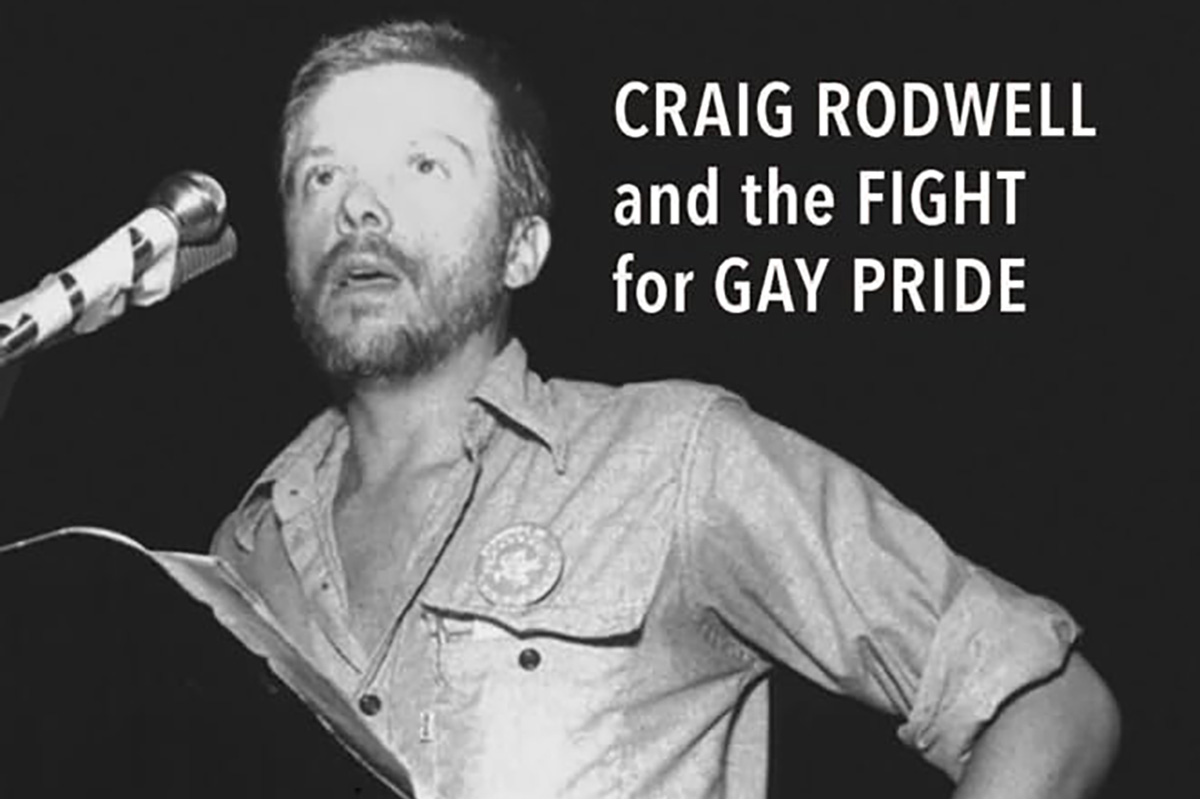Books
Trump to LGBT elders: DROP DEAD
Standing with our pioneers, #WeRefuseToBeInvisible


President Donald Trump (Washington Blade photo by Michael Key)
Four months into the Trump administration and it’s become clear that LGBT elders and their advocates are in for a big fight, with the new regime in Washington seemingly determined to erase the progress toward LGBT inclusion in federal aging policies and programs. Given the erasure of LGBT issues from White House and federal agency websites within hours of Donald Trump’s inauguration, we at SAGE were alarmed but not surprised when we learned of plans to eliminate LGBT elders from the annual survey that determines how $2 billion in publicly funded elder services gets distributed. This outrageous move sends a clear message to LGBT elders, many of whose very lives depend upon federally funded services, that the Trump administration doesn’t care whether they receive those services or not.
As the leading voice for LGBT elders nationally, SAGE responded quickly with the #WeRefuseToBeInvisible campaign – a grassroots effort to mobilize a strong response to the public comment period that the Trump administration is legally required to undertake before erasing an entire population from an important federal program. To date, SAGE’s campaign has resulted in more than 8,000 letters of opposition making their way to Washington.
Many organizations, LGBT and allies alike, have joined the cause. As Dr. Yanira Cruz, president and CEO of the National Hispanic Council on Aging, put it: “We know that Donald Trump and [Health & Human Services Cabinet Secretary] Tom Price won’t change their minds on their own, which is why we’re joining forces with SAGE to raise our voices in demanding that HHS add LGBT questions back into its survey of older adults…Because everyone, at every stage of life, deserves to be counted, heard, and treated with respect.”
A broad array of organizations – from national and local LGBT leaders like the Human Rights Campaign, the National LGBTQ Task Force and Fenway Community Health to aging sector leaders like Justice in Aging and the Leadership Council of Aging Organizations have mobilized their constituents to express opposition to the erasure of LGBT elders. A recent analysis published on Storify demonstrates the degree to which #WeWillNotBeInvisible has caught on via social media, touching a powerful nerve across LGBT communities and with allies.
There are emerging indications that at least some in Washington are listening. On April 27, a bi-partisan group of 19 U.S. senators led by Susan Collins, Republican chair of the Senate’s Special Committee on Aging, publicly demanded a reversal of the Trump administration’s plans to erase LGBT elders.
The deadline for the public comment period for the survey exclusion is May 12. SAGE and our many campaign partners will be generating opposition until the last possible moment. Unfortunately, there is every indication that, as the public comment period winds down and we await a final decision from the Trump administration on LGBT inclusion in the elder services survey, more battles are on the horizon.
The so-called “religious freedom” executive order signed by Donald Trump last week lays the groundwork for Attorney General Jeff Sessions, a long-time opponent of LGBT equality, to authorize religious-based discrimination across federally supported programs. Given the history of religion-based anti-LGBT teachings, and the fact that faith-based organizations make up more than 70 percent of the long-term care providers upon which older Americans are forced to rely, LGBT elders have every reason to be deeply concerned that they will pay a high price for the Trump administration’s determination to favor religious voices over all others. Tragically, discrimination far too often forces LGBT elders who need care and services back into “the closet” in order to protect themselves from mistreatment. We’ve made progress on that front in recent years, as SAGE has led efforts across the country to use training to improve treatment of LGBT elders by care providers. It will require extraordinary vigilance to ensure the administration’s drive to elevate religious voices – fueled by right-wing evangelical Trump supporters – does not erase that progress.
And the threats don’t stop there. On the very same day the “religious freedom” executive order was signed, the House of Representatives – in a party-line vote – succeeded in passing a slapped-together bill that would replace Obamacare with a disastrous approach to health care that favors the wealthy and dumps on everybody else. Among the many groups that would be hurt by Trumpcare, older people face the threat of health insurance premiums that are five times higher than premiums for younger people. Here again, we must fight as hard as possible to ensure that this terrible rollback in progress is stopped in its tracks.
Through all of these battles, and those to come, SAGE will continue to stand with and for our LGBT elder pioneers. We will not back down. We refuse to be invisible.
Michael Adams is CEO of SAGE.
Books
Florida’s war on Black, queer lives hidden no more
New book ‘American Scare’ exposes truth of decades of erasure, attacks

‘American Scare: Florida’s Hidden Cold War on Black and Queer Lives’
By Robert W. Fieseler
“What’s with Florida?,” Bobby Fieseler, disgusted, asked after completing his initial research into the vicious investigation of suspected homosexual teachers by the Florida Legislative Investigation Committee (FLIC) in the 1950s. How did the official animus toward all things queer happen in Florida, Fieseler pitched his publisher. We can be grateful Dutton gave him the green light for “American Scare, Florida’s Hidden Cold War on Black and Queer Lives.”

Fieseler’s book is a masterpiece of archive activism that begins in a rental van escaping Florida with some 20 boxes of historical documents meant to be seen by no one. The cartons contained a secret second copy of materials that had been held back from the jaws of the Florida State Archives in Tallahassee. Soon, more folders would surface with unredacted materials. “There are friends of Dorothy in any system,” he explains his archival detective work with a wink.
What’s with Florida? In the 1950s, it was all about legislators exposing politically helpless homosexuals to justify the committee’s investigations and budgets. The FLIC documents reveal the names of the accused “perverts,” the cops who raided the restrooms, the terrified queer informants and the professional interview techniques that would extract confessions from the victims. On another level, this was about old-school Southern racists determined to stop integration at all costs with intention to weave lies about Communist infiltration of the NAACP. Finally, Fieseler encountered first-hand an official determination to erase and lock-up this history. The statewide obsession with erasing history continues to this day. The Florida Department of Transportation this year painted over the community rainbow crosswalk memorial to the Pulse nightclub massacre victims in Orlando.
“American Scare” is such a fully documented investigation of what unfolded, it will be impossible to paint over the magnitude of this assault. The book bears witness in gory detail to the ruination of private people that exceeds in pure perniciousness the more famous “Lavender Scare.” Although the “Lavender Scare” purged many more individuals, it was about the U.S. Department of State firing public officials slimed as “pinstripe twerps.” The Florida investigations were a statewide purge using a dark politics of exposure of schoolteachers leading private lives. Fieseler quotes Remus Strickland, the head homo-hunter and executive director of the Southern Association of Intelligence Agents formed in response to the Supreme Court’s Brown v. Board of Education desegregation decision (1954), “If the Committee’s first pursuit (race and Communism) was a mandate, its second pursuit (homosexuals) was an opportunity.” Remus (that’s really this Southerner’s name) explained years later without remorse, “We first looked at the University of Florida for Communists….then we came back and did the homosexual purge.” Fieseler’s archival research reveals how far-right politicians and investigators like Strickland characterized Communists, African Americans (through the NAACP) and homosexuals as aligned “treasonously in a subversive societal infestation.”
The whole show was the creation of a wily, populist politician — a Florida “Pork Chopper” — Charley Johns, president of the Florida Senate. “Pork Choppers,” the rural, white Northern Florida wing of the old Democratic Party, controlled the state legislature from the 1930s to the 1960s. They were strongly opposed to integration, Communists, homosexuals, reapportionment and government reform. Johns owned the Charley E. Johns Insurance Agency, which insured state agencies. Fieseler’s history brings these North Florida politicians into grotesque focus. Their “power had lynched history,” he writes about his passion to excavate how they sealed and redacted the records so they would never face responsibility for their actions.
“American Scare” reveals how these Pork Choppers were willing to crush homosexuals as an instrument to maintain power. Their victims were isolated gay and lesbian teachers who could only plead for mercy, vanish or inform on one another. They were entrapped by the system itself. Fieseler tells the story of how Remus Strickland pulled Miss Poston, a physical education teacher out of her classroom surprising her with a tape recorder and a request to give a misdirecting statement about the prevention of child molestation. Suddenly Remus changed the subject: “Miss Poston, in your acts with Miss Bradshaw whom you referred to on this record, would she play the part of the aggressor…..She was known as the butch is that true?….Was there any occasion of any oral copulation?” He closed in for the kill, “Could there have been more than one time”? Miss Poston caved, “Possibly but if so only one more time.” The reel-to-reel tape is turning.
Concert pianist and music teacher William James Neal received the same taped grilling. Remus begins the interview, “You’re an educated Nigra,” confronting Neal with testimony he was a homosexual “nigra.” Years later, Neal remembered, “He told me I would never teach within the continental limits of the United States. He said he had proof I was a homosexual.” An African-American concert pianist, Neal had extensively toured the U.S. playing with major orchestras and hosting his own radio program in Florida. Neal had the self-respect and courage to take his illegal termination to the Florida Supreme Court. In 1962, the court ruled in his favor (Neal v. Bryant) handing Remus Strickland a devastating defeat, writing “The statements accused teachers allegedly made were obviously extracted under a threat of publicity.” Vindicated, William Neal nonetheless left Florida never to return.
There have been resolutions for an acknowledgment and apology. None have advanced through the Republican-controlled legislature occupied with a slew of “Don’t Say Gay” bills. “American Scare’ is larger than a small-bore history of investigations. It is the story of a Great Florida Teacher’s Purge launched to stop integration. Fieseler is done with redactions. He names names. If there is anything redemptive in this Southern hot mess, it is this: Bobby Fieseler, a queer historian, rescued the boxes and delivers readers their contents with history’s gale force.
The Blade may receive commissions from qualifying purchases made via this post.
Books
New book celebrates gay rights pioneer you’ve never heard of
Craig Rodwell was at Stonewall riots, helped start first Pride, and more

‘Insist That They Love You: Craig Rodwell and the Fight for Gay Pride’
By John Van Hoesen
c.2025, University of Toronto Press
$36.95/432 pages
Craig Rodwell is, sadly, not nearly as well known as he should be, given his accomplishments. He opened the first bookstore devoted to gay and lesbian literature. He led a chant of “Gay power!” at the Stonewall riots and contributed many articles about the struggle for equality and fair treatment. He helped organize the first Pride march. Thankfully, journalist John Van Hoesen’s new book, “Insist that They Love You,” tells Rodwell’s story.

Rodwell was born in Chicago in 1940 and spent his early years at a Christian Science-run children’s home. As a teenager, he roamed the streets, connecting with older men. One of those lovers was arrested and later died by suicide. He moved to New York to study dancing and joined the Mattachine Society, one of the first groups involved in “gay liberation.” He dated Harvey Milk, a challenging relationship, as the older Milk was still closeted while Rodwell was out and deeply involved in the cause. This was when being gay was a crime and public exposure risked getting fired and evicted.
In 1967, he opened the Oscar Wilde Memorial Bookshop (correcting anyone calling it a bookstore), which openly displayed gay and lesbian books and materials. It had large, inviting windows, different from the typical places gay people congregated. Many walked past it, working up the courage to go in. Once they did, they found a welcoming place where they could learn and connect with others. Van Hoesen writes about the diversity of the Bookshop’s employees, gay, lesbian, Black, and white, who all loved the sense of community and purpose Rodwell created.
That same year he helped form the group Homophile Youth Movement in Neighborhood and created their periodical HYMNAL. He wrote many articles for them and later, for QQ Magazine, describing the forces in straight “heterosexist” society, as he termed it, against gay people. He wrote about mafia-controlled gay bars, including the Stonewall Inn, seedy places that overcharged for watered-down drinks. He decried how the law was used to persecute gay people, describing his arrest for wearing “too-short” swim trunks. He explained what to do if arrested: never speak without a lawyer present and never provide names of other gay people. Van Hoesen helpfully includes these articles in an appendix.
Rodwell’s history of activism is impressive. In 1966, he participated in a “sip-in” protesting a law forbidding bars serving alcohol to homosexuals; it took three attempts before one refused to serve him. He and his partner happened by the Stonewall Inn when the riots began, offering the protesters support. He helped lead a group that picketed Independence Hall in Philadelphia every year as an “Annual Reminder,” arguing with organizer Frank Kameny over the required conservative dress code.
He organized the first Pride march in 1969. One of the biggest challenges was getting all the different gay rights groups, with different objectives, to work together. The police only issued the permit the morning of the march. Among the book’s photos is one of Rodwell and his partner afterwards, looking exhausted but happy.
Rodwell never sought the spotlight for his work, always working with others. Yet he often chaffed against many of the organizations’ philosophies, one of the few Mattachine Society members to use his real name. He refused to sell pornography in the Bookshop, or work with gay business owners funded by the mob. He even threw some customers out. Let’s hope this biography shines more attention on this lesser-known leader of the gay rights movement.
The Blade may receive commissions from qualifying purchases made via this post.
Books
New book a fun travelogue, memoir focused on cemeteries
‘Somebody is Walking on Your Grave’ takes readers around the world

‘Somebody is Walking on Your Grave: My Cemetery Journeys’
By Mariana Enriquez, translated by Megan McDowell
c.2025, Hogarth
$30/336 pages
The knee bone’s connected to the shin bone.
You can go up from there, or down your body’s scaffolding. The backbone’s connected to the rib bone. The hip bone to the leg bone, the wrist bone to the finger bones, and in the new book “Somebody is Walking on Your Grave” by Mariana Enriquez, translated by Megan McDowell, there’ll come a day when you won’t need any of them.

She always had an appreciation for cemeteries.
Still, they weren’t an obsession until Mariana Enriquez fell head bone over heel bones in love with a street musician while on a vacation in Italy with her mother. He took Enriquez through a cemetery on their whirlwind romance, which sealed her love for graveyards.
She never seems to miss a chance to tour them, to marvel at the beauty of statuary atop marble resting places, to see tombstones listing sideways, or to note the names and tragedies of the dead. This includes the graves of non-humans, like a horse that helped its owner escape an Argentinian uprising in 1885; and a Scottish dog who guarded his owner’s grave for more than a decade.
Enriquez visited San Sebastián, Spain, and was almost jailed for it; and she was lectured about Aboriginal graves by a white man on Rottnest Island, off the Australian coast. There was a magical sense at Sara Braun Municipal Cemetery in Chile, and an absurd couple of mysteries in Argentina. She visited just some of the 42 cemeteries in New Orleans including, of course, crypts and the grave of Marie Laveau. She spent Dios de Muertos in Mexico, and was surprised that you can live near a funeral home in Savannah and not have ghosts. She visited the catacombs in France, and argued with guides and guards in several different places, noting that people are a lot nicer when they’re dead.
In a very big way, “Somebody is Walking on Your Grave” is a fun travelogue that’s also part memoir, and taphophiles will love it. But readers who specifically add a cemetery tour to their vacation itinerary, or who obsessively scour guidebooks for graveyards to visit will enjoy author Mariana Enriquez’s observations; they’re humorous and not stuffy, lightly acknowledging the bit of the macabre that’s here. She includes history behind the cities she visits, as well as for the cemeteries, and that can be a bit longish sometimes. You may not mind, though, because her descriptions enhance any trip you might make, serving as exactly what you’d want from a real live tour guide.
But toward the end of this otherwise-delightful book, Enriquez unabashedly admits to doing something atrociously unsettling, to which she says she feels no remorse – which may be a hard forgive for readers who wouldn’t ever dream of emulating it.
This book is a fun read, up to that point, so just beware. Most of “Somebody is Walking On Your Grave” is truly interesting, but that one chapter inside here may not fully allow you to wrap your head bone around it.
The Blade may receive commissions from qualifying purchases made via this post.
-

 District of Columbia2 days ago
District of Columbia2 days ago‘Sandwich guy’ not guilty in assault case
-

 Sports2 days ago
Sports2 days agoGay speedskater racing toward a more inclusive future in sports
-

 Celebrity News4 days ago
Celebrity News4 days agoJonathan Bailey is People’s first openly gay ‘Sexiest Man Alive’
-

 Michigan4 days ago
Michigan4 days agoFBI thwarts Halloween terror plot targeting Mich. LGBTQ bars



















